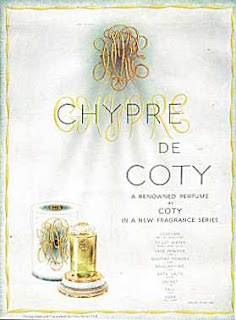During the ensuing years up till 1917 when Francois Coty introduced his famous Chypre perfume, many perfumers worked the themes of labdanum, bergamot and oakmoss into their compositions but it was not until his classic creation came on the market that the word "Chypre" became associated with a family of perfumes that displayed, at their heart, a rich , warm, earthy, mossy, resinous, green bouquet. Coty also drew upon various synthetic chemicals to "enhance" the central Chypre theme.
Following the introduction of his perfume many famous fragrance houses introduced their own unique variations of Chypre.
With the passage of time more and more synthetic ingredients were substituted for naturals which has been the standard pattern in the commerical perfume field. Many modern chypres contain very little if any of the core accord of labdanum, bergamot, and oakmoss or any of the other natural absolutes and essential oils which originally were part of a fine chypre composition. The following natural Chypre accord built around Bergamot, Labdanum and Oakmoss should serve as a good beginning formula for those who wish to create a lovely perfume.
Following the introduction of his perfume many famous fragrance houses introduced their own unique variations of Chypre.
With the passage of time more and more synthetic ingredients were substituted for naturals which has been the standard pattern in the commerical perfume field. Many modern chypres contain very little if any of the core accord of labdanum, bergamot, and oakmoss or any of the other natural absolutes and essential oils which originally were part of a fine chypre composition. The following natural Chypre accord built around Bergamot, Labdanum and Oakmoss should serve as a good beginning formula for those who wish to create a lovely perfume.

